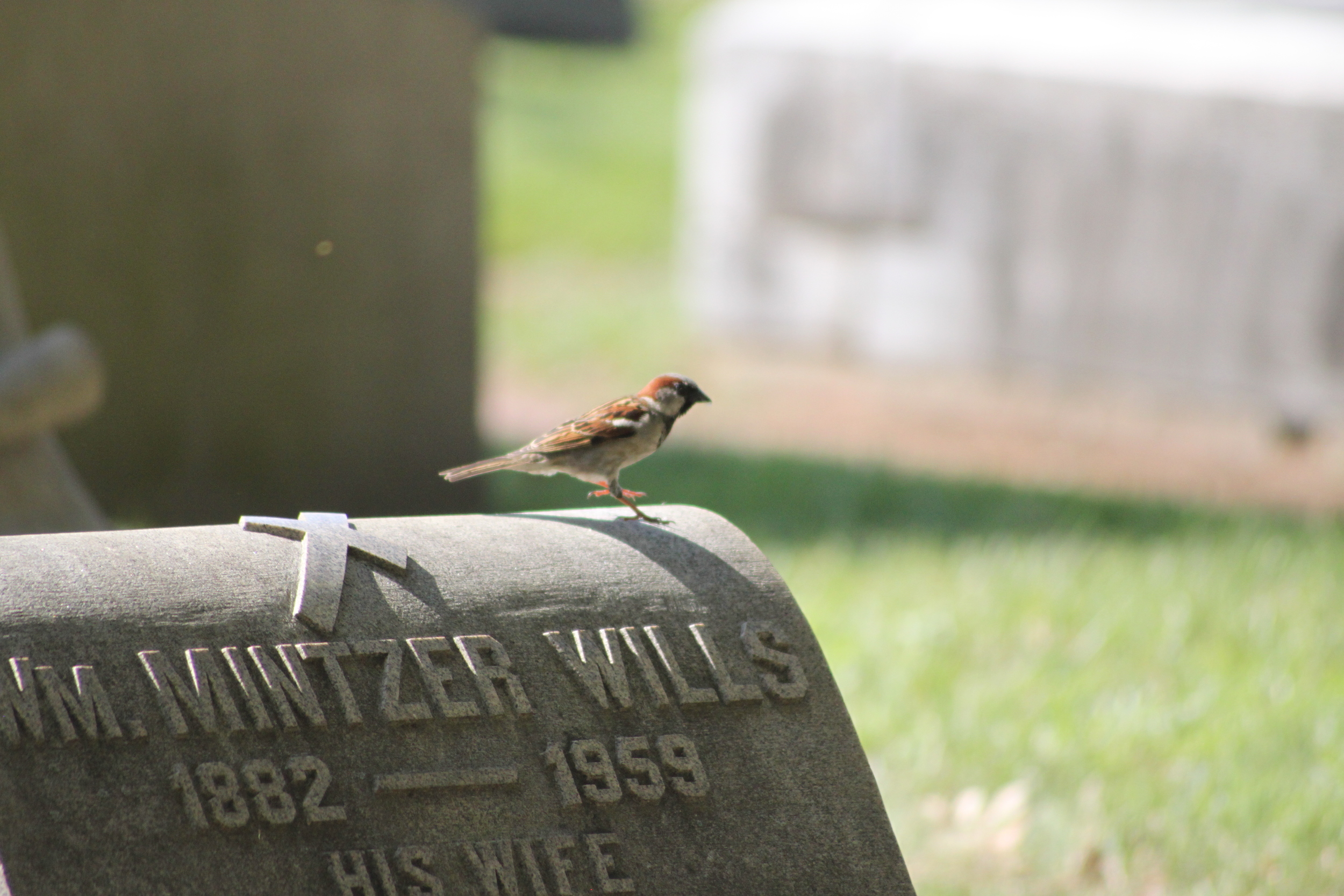Each year students from Mr. Gilligan’s AP US History (APUSH for short) class at the J.R. Masterman School complete the Cemetery History Project: an in-depth, group research project on an individual who has become a permanent resident of The Woodlands.
The students visit The Woodlands in the early fall, enjoy a Victorian Era picnic (often dressed in period garb for extra credit!), and roam the grounds in search of a headstone that speaks to them, intrigues them, and/or humors them. The students' research subject must be born before 1850, cannot be famous, and must not have been researched by prior students, or have a headstone shorter than Mr. Gilligan, who is 67 inches tall. How do we know that? Because one of the past groups created a short booklet titled "People We Could've (and Might've) Done if Mr. Gilligan Was Taller." The cover lists Mr. Gilligan's height at 67 inches, and the following pages are filled with photographs and measurements of headstones and grave-markers that they couldn’t choose because they were slightly taller than Mr. Gilligan.
After they choose a headstone, students then embark on a 5-month long adventure of rigorous research as they attempt to recreate the life of the chosen deceased. Because of their hard work and dedication over the course of the semester, we're a step closer to learning more about the individuals who make up this "garden of biographies." It’s interesting to see the intellectually investigative research of the students, but even more interesting to see their personalities shine through in their introductions, personal reflections, historical fictions, and more. The ways in which the students decorate the binders and the photographs they choose to include in their personal reflections act as reminders that the people doing the research and completing these projects are 16 and 17 years old.
Below is a glimpse of some of the incredible work of the students. This year Mr. Gilligan’s class separated into groups and researched seven of The Woodland’s permanent residents. Reporting from the Woodlands Cemetery on May 17, 2015- the following information and images are my notes from the Masterman student presentations:
1. Mark Huntington Cobb - Researched by Kyle Wilson, Nathan Syken, Annika Nordlof, David Ludwig, Jesse Carpenter
Born in 1828 in Colebrook Connecticut, Mark Huntington Cobb was a poet, writer, husband, father, newspaper owner, forward-thinking Republican, clerk, employee of the U.S. Mint and respected citizen of Philadelphia until his death in 1913. Masterman students discovered and compiled documents ranging from Cobb’s published literary works to his birth and death records. Shown here is an image of a “creative extra” that the students made: a Mark Cobb commemorative coin.
2. Theodore L. Debow - Researched by Alexandrea Gosnell, Enri Kina, Alexis Riddick, and Kevin Yang
Born in 1841 in Philadelphia, Theodore Langhe Debow was a Girard College graduate, jeweler’s apprentice, Union Army soldier, War Department clerk, Central National Bank cashier, member of the Board of Managers of the Young Men’s Christian Association, member of the Sea Isle’s City Council, and beloved husband and father until his death on August 21, 1906 of a stroke. This group of students found incredible records of Debow, from documents which stated that he was held prisoner during the Civil War, to documents of the Debow’s stays at the Tivoli Hotel in Sea Isle City, New Jersey. Shown here is a “creative extras” that the students made: one of the “trading cards,” which features a fun fact about Debow.
3. John Graham - Walter Chen, Aubrey Luk, Haoxuan Yuan, Rohith Thaiparambil, Elizabeth Zhou
Shown here is a photograph of the students dressed in period garb from their initial picnic at The Woodlands.
Born in Philadelphia in 1854, John Graham was an engineer, the beloved husband of Florence Beale, father of three children, chief engineer of the New River Railroad and Manufacturing Company, and member of the St. Andrew’s Society of Philadelphia, until he died of a cerebral hemorrhage on February 7, 1924. The group of students who researched Graham found incredible records like Graham’s baptism certificate and a record of his active membership of the Philadelphia Cricket Club.
4. Albert Gumpert - Researched by Jack Aaron, Jean Donohue, Ali Landers, and Owen Fox
Born in 1847 in Bernburg Germany, Albert F. Gumpert was a German immigrant, businessman, cigar manufacturer, husband, traveler, father, founder of the Cigar Manufacturers’ Protective Association, Master Mason, and family man until he died in Heidelberg, Germany on May 31, 1894. The students could not find a definitive cause of death, as they found various obituaries that stated he died from consumption, neurasthenia, and falling off of a bridge… all of which the audience found hilarious. It was a teachable moment, though, because there will always be discrepancies when performing primary source research. Shown here is a print that depicts the Gumpert Brother’s Cigar Store on 1341 Chestnut Street, just one of the many documents that the students discovered
5. George C. Leib - Joel Chacko, Valentino Papa, Joe Previdi, Manfred Thomas, and Alex Zharovsky
Born in Pennsylvania in 1809, George Clinton Leib was a graduate of Norwich University, graduate of University of Pennsylvania, doctor, naturalist, leading member of the Academy of Natural Sciences, ornithologist, researcher for the National Institute for the Promotion of Science, second sergeant of the Brady Guard, traveler, explorer, discoverer of the Myotis Leibii, and 44 year resident at the Pennsylvania Hospital for the Insane. Although George Leib spent most of his life institutionalized, the students found many documents about him, including many of his published works. Shown here is a “creative extra” that the students made: a “trading card” that depicts the species of bat that Leib discovered, the Myotis Leibii.
*At the Woodlands our interests are peaked and we want to know more about the dynamic life of Leib- hopefully more research to come!
6. William Henry Parish - Azariah Harris, Jeremy Romano, Vicky Zheng, Brandon Balsirow
Born in 1845 in Mississippi, William Henry Parish M. D. was a graduate of Jefferson Medical College, volunteer in the Confederate Army, resident physician at Pennsylvania Hospital, Chief of the Gynecological Clinic at Jefferson Medical Hospital, Professor of Gynecology at Philadelphia Polyclinic, Professor of Anatomy at the Women’s Medical College of Pennsylvania, Vice-President of the American Gynecological Society, President of the Philadelphia Obstetrical Society, Fellow at the College of Physicians, member of the Philadelphia County Medical Society, member of the Medical Society of Pennsylvania, and member of the American Medical Association until his death on July 19, 1903 of myocarditis, which was defined as “inflammation of the heart muscle.” Shown here is a “creative extra” that the students made: an illustrative comic strip of the life of William Henry Parish.
7. Harry Peale - Fiona Bardhoshi, Siduri Beckman, Emily Bosaczyk, Calla Bush St. George
Born in 1830 in Philadelphia, Harry Peale was the grandson of Charles Willson Peale and a clerk and eventually partner at Thomas A Biddle & Company, a Civil War draftee who paid the commutation fee in order to avoid service in the Union Army, adoptive and biological father, husband, and widower until his death on July 16, 1904. This group of students found many records about Harry Peale and of the whole Peale family, as the Peales were a prominent Philadelphia family. Shown here is a photograph of the group of students in front of Harry Peale’s former home on 4415 Baltimore Avenue. Many Peale’s are buried here at the Woodlands Cemetery, and are a prominent Philadelphia family, as Charles W. Peale founded the first public museum in the country.
Masterman students have compiled over 100 biographies of permanent residents at The Woodlands, and their work is so important to us! They are solving mysteries about all of the people buried here, developing research skills, learning to place the history of a person within the context of Philadelphia and the nation, and so much more! We love the work that the Masterman students produce, and wait excitedly to add more stories to our Garden of Biographies.
--- By Grace DiAgostino, Graduate Intern




























